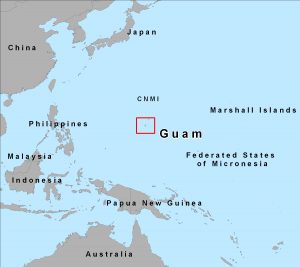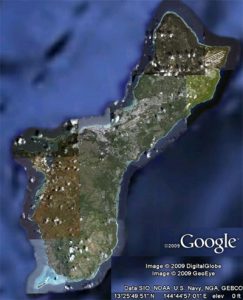Geography
The island of Guam is a U.S. territory in the Western Pacific, approximately 2400 km (1500 mi) southeast of Japan and about 2200 km (1400 mi) east of the Philippines. Guam is the southernmost island in the Marianas Archipelago, which is comprised of 15 islands spanning over 800 km (500 mi). With a land area of about 550 square km (212 square mi), Guam is the largest island in the Marianas, and is also the largest island in Micronesia.
Geology
Guam is estimated to be around 30 million years old. The northern half of the island is comprised of a raised, relatively flat limestone platform surrounded by steep cliffs which plunge several hundred feet to the coast. The southern half of the island, on the other hand, is hilly and comprised mainly of volcanic rock. The highest point on the island is about 1200 ft (400 m) above sea level.

People
Approximately 175,000 people currently live on Guam, with most living in the northern villages of Dededo, Yigo, and Tamuning. The Chamorros are the indigenous people of Guam, believed to have first arrived on the island about 4000 thousand years ago. Chamorros are the largest ethnic group on the island, but Guam is also home to civilians from the continental U.S. and people from other countries such as the Federated States of Micronesia, Palau, the Republic of the Marshall Islands, the Philippines, Japan, Korea, and other countries from around the world. The U.S. military maintains a large presence on the island, with more than 10,000 military personnel stationed at the Andersen Airforce Base in northern Guam and the Navy Base in central Guam.
Environment
Guam is surrounded by approximately 110 square km of shallow coral reefs, with an additional 110 acres occuring in offshore waters. Much of Guam is surrounding by a fringing reef, but the island also possesses patch reefs, shallow and deep lagoonal reefs, submerged banks, and other reef types. Guam’s reefs are home to over 5,000 known marine organisms, with likely many thousands more awaiting discovery. Many of Guam’s reefs, however, are under assault by numerous threats – mostly local threats caused by people living on the island. Guam’s terrestrial environment is fairing even worse, with the loss of most of the native bird species as a result of the invasive brown tree snake, the replacement of native plants by introduced species, and intense development pressure on the remaining developeable land. Still, Guam is a beautiful island, with hidden natural treasures awaiting those willing to seek them out.
